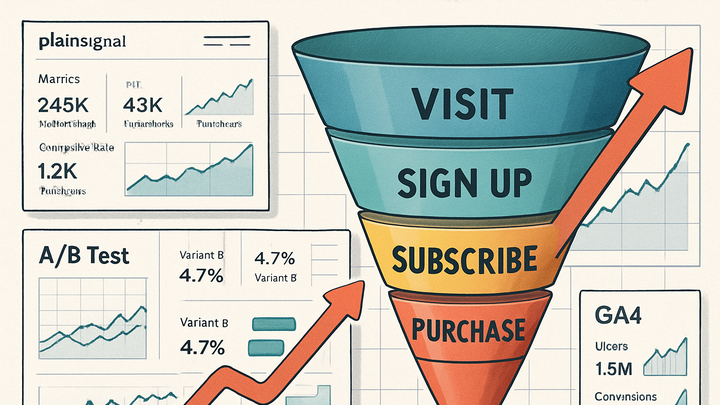Published on 2025-06-28T03:41:24Z
What Is Conversion Rate Optimization (CRO)? Best Practices and Examples
Conversion Rate Optimization (CRO) is the systematic process of increasing the percentage of visitors who take a desired action on a website or application. By leveraging data from analytics platforms such as PlainSignal’s lightweight, cookie-free dashboards or Google Analytics 4 (GA4), teams can analyze user behavior, identify bottlenecks in the conversion funnel, and run targeted experiments. CRO combines quantitative metrics—like click-through rates, bounce rates, and goal completions—with qualitative insights from user feedback and heatmaps. Common techniques include A/B testing, multivariate testing, landing page optimization, and personalization. Through continuous measurement and iteration, CRO drives higher ROI on existing traffic without necessarily increasing ad spend. Successful CRO requires clear goals, robust tracking implementations, and disciplined hypothesis testing to unlock incremental improvements over time.
Conversion rate optimization (cro)
CRO is the process of increasing website or app conversion rates through data analysis, testing changes, and optimizing experiences.
Why CRO Matters in Analytics
Optimizing conversion rates is essential because it directly impacts revenue, user engagement, and marketing ROI. With CRO, businesses make the most of existing traffic by turning more visitors into customers or leads, reducing acquisition costs and improving overall profitability. Data-driven improvements also enhance user satisfaction by removing friction points and improving usability. Continuous CRO efforts enable teams to adapt to changing user behavior and market conditions, creating a culture of experimentation and growth. Platforms like PlainSignal and GA4 provide the insights needed to prioritize optimization opportunities effectively.
-
Revenue and roi
Improved conversion rates lead to higher revenue per visitor, boosting return on investment without additional advertising spend.
-
User experience
CRO enhances user experience by simplifying navigation, improving page speed, and delivering relevant content, which reduces bounce rates and increases engagement.
-
Data-driven culture
Regular testing and analysis foster a culture of experimentation, allowing teams to make informed decisions and iterate on successful strategies.
Key Strategies for Conversion Rate Optimization
A structured approach to CRO involves defining clear hypotheses, running controlled experiments, and analyzing results. Common strategies target page elements, user flows, and audience segments to uncover improvement areas.
-
A/b and multivariate testing
Compare different versions of page elements—such as headlines, images, or CTAs—to determine which variation yields the highest conversion rate.
-
Hypothesis definition
Start with a clear hypothesis about which change will improve conversions and why.
-
Test design
Set up control and variant groups, ensuring sufficient sample size for statistical significance.
-
Result analysis
Use statistical tools to verify whether observed differences are meaningful and actionable.
-
-
Funnel and journey analysis
Map the user journey from landing page to conversion, identifying drop-off points and friction in each step.
-
Drop-off identification
Analyze where users exit the funnel most often to prioritize optimization efforts.
-
Step optimization
Refine forms, navigation, and page layout to streamline the path to conversion.
-
-
Landing page optimization
Focus on improving headline clarity, visual hierarchy, and call-to-action placement to capture visitor attention and guide them toward conversion.
-
Headline testing
Experiment with different headline messages to see which resonates best with the audience.
-
Cta enhancement
Test CTA text, color, size, and positioning to maximize click-through rates.
-
-
Personalization and segmentation
Tailor content and offers based on user attributes like location, behavior, or referral source to increase relevance and conversion likelihood.
-
Behavioral targeting
Serve content variations based on previous user behavior or on-site interactions.
-
Demographic segmentation
Customize messaging for different user segments to address their unique needs.
-
Tools and Platforms for CRO
Selecting the right tools is critical for capturing accurate data, conducting tests, and tracking optimization progress. Here are two popular platforms used in modern analytics stacks.
-
PlainSignal
A lightweight, cookie-free analytics solution that provides simple dashboards and real-time insights to help teams monitor key metrics without compromising user privacy.
-
GA4 (google analytics 4)
Google’s latest analytics platform offering event-based tracking, advanced segmentation, and detailed reporting features for comprehensive understanding of user interactions.
Implementing CRO Tracking Code
Proper tracking code setup ensures accurate data collection for conversion analysis and experiment measurement. Below are examples for PlainSignal and GA4.
-
PlainSignal implementation
Add this snippet to your site’s <head> to enable cookie-free analytics with PlainSignal:
-
Code snippet
<link rel="preconnect" href="//eu.plainsignal.com/" crossorigin /> <script defer data-do="yourwebsitedomain.com" data-id="0GQV1xmtzQQ" data-api="//eu.plainsignal.com" src="//cdn.plainsignal.com/plainsignal-min.js"></script> -
Attributes explanation
The
data-idattribute links to your account,data-dospecifies your domain, and the preconnect link optimizes load performance.
-
-
GA4 implementation
Insert the following gtag.js snippet to start tracking events and conversions in Google Analytics 4:
-
Code snippet
<!-- Global site tag (gtag.js) - Google Analytics --> <script async src="https://www.googletagmanager.com/gtag/js?id=G-XXXXXXXXXX"></script> <script> window.dataLayer = window.dataLayer || []; function gtag(){dataLayer.push(arguments);} gtag('js', new Date()); gtag('config', 'G-XXXXXXXXXX'); </script> -
Measurement id
Replace
G-XXXXXXXXXXwith your GA4 Measurement ID to link data to your property.
-
Measuring and Analyzing CRO Results
After implementing changes and running tests, it’s crucial to track performance metrics, interpret results, and iterate on insights to drive continuous improvement.
-
Conversion rate calculation
Conversion rate = (Number of conversions ÷ Total visitors) × 100. This metric quantifies the effectiveness of your optimizations.
-
Key performance indicators (kpis)
Monitor metrics such as bounce rate, average session duration, goal completion rate, and revenue per visitor to gauge the broader impact of your CRO efforts.
-
Reporting and dashboards
Use dashboards in PlainSignal or GA4 to visualize trends, segment performance by audience, and share insights with stakeholders for data-driven decision making.
